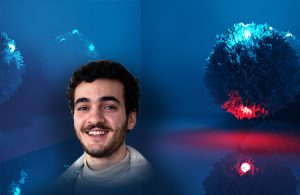Amphithéâtre Durand, bâtiment Esclangon

Damien Simonot, doctorant dans l’équipe Nanostructures et optique
Elargissement spectral dans l’émission de boîte quantique individuelle sous forte puissance d’excitation
Résumé
Le processus d’émission d’une boîte quantique cœur/coquille de semi-conducteur CdSe/CdS à basse puissance d’excitation est généralement décrit par un système à deux niveaux. Néanmoins, sous forte puissance d’excitation, des phénomènes tels que l’élargissement spectral et la variation non-linéaire de l’intensité d’émission se manifestent. Afin de mieux comprendre ces phénomènes, nous avons développé un modèle basé sur une description statistique d’occupation des niveaux calculés via la résolution de l’équation de Schrödinger pour un exciton confiné dans une structure à 0D. Notre modèle tient en compte de plusieurs facteurs, tels que l’alignement des bandes de conduction entre le CdSe et le CdS (dont la valeur est estimée dans cette thèse car elle est indéterminée dans la littérature), la structure fine, les effets de pression et les interactions avec les ligands. Ces éléments sont intégrés pour déterminer les transitions excitoniques. A partir du calcul de toutes les transitions, le spectre d’absorption en collectif d’échantillon de CdSe/CdS est ajusté avec les données expérimentales afin de tester la robustesse du modèle.
Afin d’expliquer l’élargissement spectral, la distribution de Fermi-Dirac permet de décrire le peuplement des niveaux des électrons et des trous. Cependant, ce modèle implique un certain nombre de paramètres corrélés qui ne sont pas connus. Pour résoudre ce problème complexe à plusieurs dimensions et une distribution de solution multimodal, nous avons utilisé un algorithme d’échantillonnage basé sur une analyse bayésienne. Les résultats de notre étude ont démontré que l’élargissement spectral observé est principalement attribuable à la recombinaison radiative des excitons d’énergies supérieures à la transition fondamentale.
Mots clés : Boîte quantique, CdSe/CdS, nanocristaux semiconducteurs, fluorescence, exciton, Schrödinger, Fermi-Dirac, problème multimodal, Bayes.
Spectral broadening in single quantum dot emission under high excitation power
Abstract
The emission process of a CdSe/CdS semiconductor core/shell quantum dot at low excitation power is generally described by a two-level system. However, under high excitation power, phenomena such as spectral broadening and non-linear variation of the emission density occur. To better understand these phenomena, we have developed a model based on a statistical distribution of level occupation via the resolution of the Schrödinger equation for an exciton confined in a 0D structure.
Our model considers several factors, such as the alignment of conduction bands between CdSe and CdS (the value of which is estimated in this thesis because it is undetermined in the literature), the fine structure, pressure effects and interactions with ligands. These elements are integrated to determine the excitonic transitions. The model is test by fitting it with the experimental collective absorption spectrum of solution of CdSe/CdS.
To explain the spectral broadening, the Fermi-Dirac distribution to describe the population of the electron and hole levels. However, this model involves several correlated parameters that are not known. Due to this complex problem with high dimensions and multimodal solution, we used a nested sampling algorithm based on Bayesian analysis. The results of our study showed that the observed spectral broadening is mainly due to radiative recombination of exciton which have higher energy that the first excited state.
Keywords: quantum dot, CdSe/CdS, semiconductor nanocrystals, fluorescence, exciton, Schrödinger, Fermi-Dirac, multimodal problem, Bayes.
Jury
- Mme Emmanuelle DELEPORTE Professeure LUMIN Rapporteure
- M Jean-Jacques GREFFET Professeur LCF Rapporteur
- M. Gérard COLAS DES FRANCS Professeur ICB Examinateur
- M Daniel SUCHET Maître de conférences IPVF Examinateur
- Mme Angela VASANELLI Professeure LPENS Examinatrice
- M. Aloyse DEGIRON Directeur de recherche MPQ Invité
- Mme Agnès MAITRE Professeure INSP Directrice de thèse

